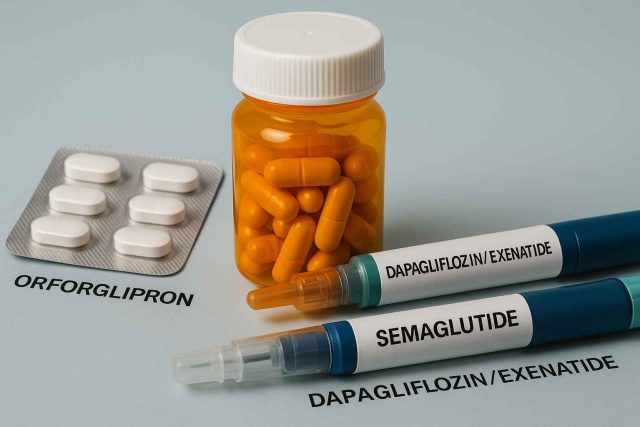Table of Contents
- Introduction
- Innovations in GLP-1 Receptor Agonists
- Advances in SGLT2 Inhibitors
- Emerging Combination Therapies
- Conclusion
- FAQs
Introduction
In 2025, the landscape of diabetes medications is evolving rapidly, offering clinicians an expanded arsenal to manage type 2 diabetes effectively. With the introduction of novel therapies and combination treatments, healthcare providers have more options to tailor interventions to individual patient needs. This roundup provides an overview of the most recent advancements in diabetes medications, highlighting their mechanisms, benefits, and clinical implications.
Innovations in GLP-1 Receptor Agonists
Glucagon-like peptide-1 (GLP-1) receptor agonists have become a cornerstone in diabetes management, primarily due to their efficacy in glycemic control and weight reduction. Recent developments have focused on enhancing patient adherence and minimizing side effects.
One notable advancement is the development of oral GLP-1 receptor agonists, such as orforglipron. Unlike traditional injectable forms, orforglipron offers the convenience of oral administration, potentially improving patient compliance. Clinical trials have demonstrated its effectiveness in lowering HbA1c levels and promoting weight loss, with a safety profile comparable to existing GLP-1 therapies.
Additionally, combination therapies like cagrilintide/semaglutide are being explored to enhance therapeutic outcomes. These combinations aim to leverage the synergistic effects of different hormonal pathways to achieve better glycemic control and weight management.
Advances in SGLT2 Inhibitors
Sodium-glucose cotransporter-2 (SGLT2) inhibitors have gained prominence for their dual benefits in glycemic control and cardiovascular protection. The latest entrants in this class are focusing on improved efficacy and safety profiles.
Bexagliflozin, marketed as Brenzavvy, is a recent addition to the SGLT2 inhibitor category. It has shown promise in lowering blood glucose levels and reducing the risk of cardiovascular events in patients with type 2 diabetes. Its once-daily oral administration simplifies the treatment regimen, potentially enhancing adherence.
Moreover, ongoing research is investigating the potential of SGLT2 inhibitors in managing conditions beyond diabetes, such as chronic kidney disease and heart failure, further broadening their therapeutic scope.
Emerging Combination Therapies
The trend towards combination therapies in diabetes management aims to address multiple pathophysiological aspects of the disease simultaneously. By targeting different mechanisms, these therapies can offer comprehensive glycemic control and mitigate associated complications.
A notable example is the combination of dapagliflozin, an SGLT2 inhibitor, with exenatide, a GLP-1 receptor agonist. This duo has demonstrated superior efficacy in lowering HbA1c levels and promoting weight loss compared to monotherapy. Patients on this combination therapy have also reported improved quality of life and reduced risk of hypoglycemia. KnowridgeSmiles Med Supply
Such combination approaches are particularly beneficial for patients with coexisting conditions, allowing for a more holistic treatment strategy.
Conclusion
The year 2025 marks a significant milestone in the evolution of diabetes medications. With the advent of oral GLP-1 receptor agonists, enhanced SGLT2 inhibitors, and innovative combination therapies, clinicians are better equipped to provide personalized and effective care for patients with type 2 diabetes. Staying abreast of these developments is crucial for optimizing treatment outcomes and improving patient quality of life.
FAQs
What are the benefits of oral GLP-1 receptor agonists over injectable forms?
Oral GLP-1 receptor agonists, like orforglipron, offer the convenience of oral administration, which can improve patient adherence and comfort compared to injectable forms.
How do SGLT2 inhibitors contribute to cardiovascular health?
SGLT2 inhibitors not only lower blood glucose levels but also have been shown to reduce the risk of cardiovascular events, making them beneficial for patients with type 2 diabetes and heart disease.
Are combination therapies more effective than monotherapies in diabetes management?
Combination therapies can be more effective as they target multiple pathways involved in glucose regulation, potentially offering better glycemic control and additional benefits like weight loss.
What should clinicians consider when prescribing new diabetes medications?
Clinicians should evaluate the patient’s overall health, comorbidities, risk of side effects, and preferences to tailor the most appropriate and effective treatment regimen.
Where can I find more detailed information on the latest diabetes medications?
For comprehensive reviews and updates, visit Diabetes In Control and consult resources like the American Diabetes Association’s Standards of Care, and the American Diabetes Association.
This content is not medical advice. For any health issues, always consult a healthcare professional. In an emergency, call 911 or your local emergency services.
